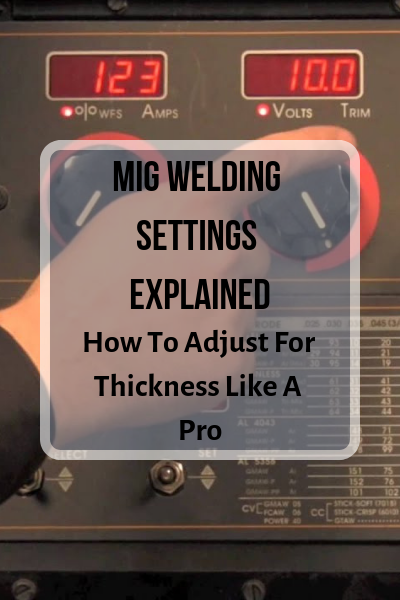
If you’re welding with one of today’s best MIG welders, then it is important to have your equipment on the proper settings for the thickness of metal that you’re using.
This guide will take you through the common settings for aluminum, stainless, and steel.
Metal Thickness Settings for Aluminum
For aluminum, ER4043 is the wire type which is used most often for all-purpose work. You can choose ER5356 if your weld properties need more rigidity and strength. Make sure that argon is used for your shielding gas, use the shortest gun possible if you’re unable to use a spool, and keep the gun straight whenever possible.
· 1/8 Inch: .035 at 350-400 ipm or 1.2mm at 240-270 ipm.
· 3/6 Inch: .035 at 425-450 ipm or 1.2mm at 300-325 ipm.
· 1/4 Inch: 1.2mm at 350-375 ipm or 1.6mm at 170-185 ipm.
· 5/16 Inch: 1.2mm at 400-425 ipm or 1.6mm at 200-210 ipm.
· 3/8 Inch: 1.2mm at 450-480 ipm or 1.6mm at 220-230 ipm.
· 7/16 Inch: 1.6mm at 240-270 ipm with 280 amps.
· 1/2+ Inch: 1.6mm at 290-399 ipm with 300 amps.
Metal Thickness Settings for Stainless Steel
When you’re using a MIG welder for stainless steel, you will find that the process is not as difficult as it is when you’re trying to weld aluminum. Stainless steel does, however, have certain properties which make it different than common steel when welding. A three-part mix of argon, helium, and carbon dioxide or a spray shielding gas are your best options for welding stainless.[1]
· 18 Gauge: .035 at 120-150 ipm, 20 volts, and 50-60 amps.
· 16 Gauge: .035 at 180-205 ipm, 20 volts, and 70-80 amps.
· 14 Gauge: .035 at 230-275 ipm, 20-21 volts, and 90-110 amps.
· 12 Gauge: .035 at 300-325 ipm, 20-21 volts, and 120-130 amps.
· 3/16 Inch: .035 at 350-375 ipm, 21 volts, and 140-150 amps.
· 1/4 Inch: .035 at 400-425 ipm, 21 volts, and 160-170 amps.
· 5/16 Inch: .035 at 450-475 ipm, 22 volts, and 180-190 amps.
· 3/8 Inch: 1.6mm at 140-170 ipm, 25 volts, and 250-275 amps.
· 7/16 Inch: 1.6mm at 170-200 ipm, 27 volts, and 275-300 amps.
· 1/2 Inch: 1.6mm at 200-230 ipm, 32 volts, and 300-325 amps.
For stainless metals which are 3/8-inch or greater in thickness, a switch in your shielding gas to 98% argon and 2% oxygen is also recommended.
Metal Thickness Settings for Common Steel
When you’re welding common steel, there are two wire types that can be used. All-purpose welding is usually performed with ER70S-3 wire, while ER70S-6 is used when more deoxidizers are required. The latter is recommended for welding projects which involve rusted or dirty steel.
These wires must be used with a C-25 shielding gas (75% argon/25% CO2), used indoors or where there is no wind, and is generally for fabrication work.
· 22 Gauge: .030 at 90-100 ipm, 15-17 volts, and 40-55 amps.
· 20 Gauge: .030 at 120-135 ipm or .035 at 105-115 ipm, 15-18 volts, and 50-60 amps.
· 18 Gauge: .030 at 150-175 ipm, .035 at 140-160 ipm, or .045 at 70 ipm, 16-19 volts, and 70-80 amps.
· 16 Gauge: .030 at 220-250 ipm, .035 at 180-220 ipm, or .045 at 90-110 ipm, 17-20 volts, and 90-110 amps.
· 14 Gauge: .030 at 250-340 ipm, .035 at 240-260 ipm, or .045 at 120-130 ipm, 17-21 volts, and 120-130 amps.
· 1/8 Inch: .035 at 280-340 ipm or .045 at 140-175 ipm, 18-24 volts, and 140-170 amps.
· 3/16 Inch: .035 at 320-380 ipm or .045 at 160-195 ipm, 18-25 volts, and 160-190 amps.
· 1/4 Inch: .035 at 360-420 ipm or .045 at 185-220 ipm, 21-25 volts, and 180-210 amps.
· 5/16 Inch: .035 at 400-520 ipm or .045 at 210-270 ipm, 21-26 volts, and 210-250 amps.
· 3/8 Inch: .035 at 420-520 ipm (short circuit transfer) or .045 at 220-375 ipm, 23-27 volts, and 220-300 amps.
· 1/2+ Inch: .045 at 390 ipm, 29-30 volts, and 315+ amps.
At 1/8-inch thickness or greater, you may opt for a 98% argon and 2% oxygen mix for welding if you are in a flat or slightly horizontal position.
A Few Concluding Notes
IPM stands for “inches per minute.” This is your travel speed for the weld that is deposited and should not be confused with your wire feed speed, which is often abbreviated as WFS.
These are the MIG welding thickness settings that are based on a standard solid core welding calculator. It is essential to remember that these suggested settings are only estimates and should be treated as an approximate setting. Always test your welds to ensure that they will meet or exceed your specifications.














